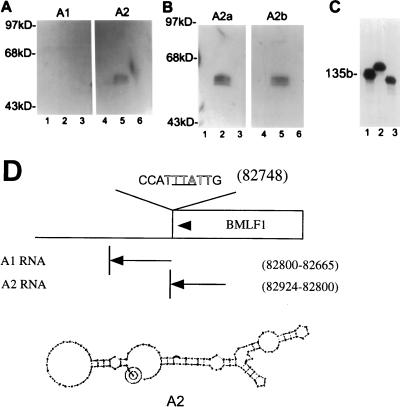FIG. 6.
Mta binds a 135-base sequence within BMLF1, as determined by Northwestern analysis of the binding of nonoverlapping BMLF1-specific RNA probes to GST-Mta. (A) Protein blots identical to those in Fig. 5A were probed with different RNAs corresponding to sequences within the BMLF1 3′ region. The A1 probe encompasses the first base of the naturally occurring poly(A) signal and continues in the 3′ direction for 139 bases. The A2 probe comprises 130 bases upstream of the start of A1 and is entirely within the BMLF1 ORF. A2 retains the ability to bind Mta, whereas A1 shows no interaction. (B) Subdivision of the A2 probe failed to identify a single interactive region. The A2a probe is the 5′ half of A2, and the A2b probe is the 3′ half of A2; both probes bound GST-Mta. (C) All probes were analyzed on 8% urea-polyacrylamide gels for integrity. Full-length probes of comparable specific activity were generated. A known 135-base (135b) control RNA (lane 1) was used as a size marker for the A1 (lane 2) and A2 (lane 3) probes. (D) Schematic showing the probes, their relative genomic positions, and the predicted secondary structures of the Mta binding A2 RNA. The polyadenylation signal (outlined type), translational termination codon (underlined), and direction of transcription (arrowheads) are indicated.

